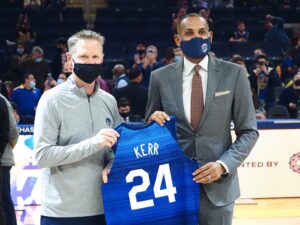Perhaps the horrific broken ankle that ended Gordon Hayward‘s season before it had really begun was an omen. This week in the NBA, three All-Star injury replacements were named. Injuries ended the seasons of Andre Roberson, DeMarcus Cousins and Mike Conley. Kawhi Leonard, one of the best players in the league, only played nine games this season due to a mysterious quad ailment. Isaiah Canaan suffered a gruesome leg injury that looked all too reminiscent of Hayward’s.
As more and more players get hurt, voices around the league begin to raise important questions. Is this year really worse than other seasons? And if so, why are so many players getting hurt? What can we do to prevent these injuries? We will take a look at each of these questions.
The NBA’s Injury Problem
Are there more injuries this year?
The short answer is that we are not sure. Since this entire season has not played out, we do not know how many injuries we will see. The incomplete nature of the season makes it impossible to compare it accurately to previous seasons.
But the small sample size we have seen thus far does not look good. Instreetclothes.com notes that through the first 20 games of this season, the number of games lost to injuries is up 18 percent from last year. This is an enormous jump, but the year did start off abnormally badly for injuries. While this exponential trend did drop off somewhat, the injuries continue to amass. On January 26th, the number of games missed due to injuries surpassed 3000. Last year, the league did not reach that mark until March 1st.
The severity of injuries is up from last year as well. Last year only five players had sustained season-ending injuries at this point in the season. This year there have been eight.
Part of an Upward Trend
Even if these statistics point to a concerningly high rate of injuries this year, it is most likely an anomaly. In a league that has been around for as many years as the NBA, there are bound to be some years that happen to have more injuries. However, it is concerning that this increase in injuries is part of a greater trend. According to a study done by Chad Starkey of NBA injuries, game-related injuries increased 12.4 percent from the 1988/89 season to the 1997/98 season. Since this study was compiled over ten years, it holds a great deal more weight than any comparisons drawn to this season.
Unfortunately, this is not the only data that says injuries are increasing. Baxter Homes and Tom Haberstroh noted that injuries to rotation players in the playoffs have climbed from 34 in 1996 to 61 in 2016. The league cannot ignore this near doubling of playoff injuries in just two decades.
Why are there more injuries?
On the surface, it does not make sense that there should be more injuries now than in the past. After all, NBA players are taking better care of their bodies now than ever before. Our medical science is way, way better. We know more about healthy eating as well as the risks of smoking and excessive alcohol. Finally, players are playing fewer minutes now, so there should be a lower risk for injury.
However, this increase in knowledge actually could be “causing” the increase in injuries. Since we have better diagnostic tools, we recognize more injuries sooner, which means players are being treated when previously we may not have known there was anything wrong with him. In addition, we are more aware of the value of treating small problems before they become a huge deal, and are less controlled by the idea of playing through pain to prove one’s “manliness.” This allows players to sit out more often than their predecessors.
Specialization
However, today’s modern players face challenges that those in the past did not deal with. Perhaps the biggest example of this is the rise of one sport athletes. Today, many kids start specializing in a single sport at a much younger age than ever before. This specialization can help kids develop advanced skills at an earlier age, but it comes at a price.
Tim S. Grover of Sports Illustrated explains this idea: “At the earliest ages, a child’s undeveloped body isn’t prepared for the punishing physical demands of intense athletic activity. Kids are designed to be active, to play, to use their entire bodies—not to work on the same move over and over and over.”
This belief is confirmed by Timothy McGuine’s study on specialization and lower extremity injuries. He found that high school athletes who have a high level of specialization have an 85 percent higher incidence of lower extremity injury. By the time these kids get to the NBA, they already have years worth of damage to crucial structures in their bodies. At some point, an injury is bound to happen.
Bigger Players
The other issue that could be causing higher rates of injury is increased player size. Tothemean.com did an interesting analysis of player size over time. They found that the mean height of NBA players increased from around 6’3″ at the beginning of the league to 6’7″ in modern times. Player weight also underwent a significant shift, from around 175 pounds in the early days to 220 pounds today.
Players who are heavier and taller put more strain on their bodies when they play. When combined with years of specialization before their body has finished growing, it creates a potentially dangerous combination.
Fatigue
When players get tired, they become more susceptible to injury. As stated by the Cleveland Clinic Foundation, “Fatigue is a contributing factor in many of the injuries that occur on the basketball court. As players run low on energy, their form deteriorates, their reaction time slows, and they lose stability in certain joints. This leaves them much more susceptible to injury than they are when they’re fresh.”
Though fatigue-related injuries are nothing new to the NBA, that does not mean we should not address them. Many relatively common, devastating injuries have their roots in player exhaustion. Take DeMarcus Cousins’ recent Achilles tear, for example. This injury is difficult to recover from, and many players who suffer it never return to their pre-injury caliber of play. Studies have shown that fatigue is a contributing factor to Achilles tendon ruptures. If we could combat fatigue effectively, perhaps we could prevent more injuries like Cousins’.
What can we do to fix the injury problem?
Injury prevention begins with making sure players get enough rest. We can accomplish this in a few different ways. First, it might be time to shorten the NBA season. Of course, there are drawbacks to this idea. Fewer games mean less content and less money. However, if we can keep players healthy, especially crowd-drawing stars, it would be worth it to see fewer games.
If we cannot shorten the NBA season, there are other options for preventing player exhaustion. While it is not enjoyable for fans, resting players is a viable option. The champion of resting, Gregg Popovich and the San Antonio Spurs organization, have shown just how effective this strategy can be. This year’s injury-filled season is a bit of an anomaly for the black and silver. Since the 2005/06 season San Antonio has been the most successful franchise at preventing games missed due to injury, Instreetclosthes.com reports.
Finally, we can combat fatigue by having players, especially stars, play fewer minutes. Some players who are lighter and smaller, or play mostly on the perimeter, may be able to handle a heavier workload without sustaining serious injury. But for players who are larger and have to carry more weight, are constantly making explosive maneuvers or are driving into contact often, lighter minutes can help them stay fresh. While it is not as fun for fans to watch when there are no stars in the game, it would be unquestionably worth it if it would keep players healthy.
Prevention from Childhood
While all of these ideas have the potential to help prevent injuries, they all are starting at the NBA level. We are working with players who already have sustained damage to important structures. No matter what, they will be susceptible to injury.
If we want to keep players healthy, we should start by encouraging kids to practice in ways that promote their athletic future, not prevent it. One sport athletes put unnecessary strain on still-growing structures that can lead to injuries, both as a kid and in later life. Coaches of young athletes should encourage them to play multiple sports and use good form so they do not harm their bodies. Perhaps more importantly, we should not push kids into year-round training and intense athletic workloads. It does not matter if they can barely make a layup or are the next Michael Jordan, these young players need time to grow up and just be kids.
The NBA has done a good job so far at trying to prevent injuries. The league has improved the scheduling to allow for less back to backs and partnered with a sports science lab to predict injury risk for players. Unfortunately, it is not enough. There is still an upward trend in injuries, and this year we have seen players getting hurt at a worrying pace. Perhaps the solution is giving players more rest, or discouraging specialization in young athletes. Or maybe it is something else entirely. One thing is for certain, however: the league needs to make finding a way to combat this injury epidemic a top priority.
Main Photo






